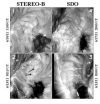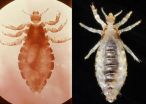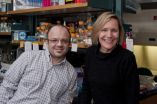(Press-News.org) Daejeon, the Republic of Korea, April 9, 2012—The Korea Advanced Institute of Science and Technology (KAIST) announced that a research team from the Department of Materials Science and Engineering has developed a technology that enables scientists and engineers to observe processes occurring in liquid media on the smallest possible scale which is less than a nanometer.
Professor Jeong Yong Lee and Researcher Jong Min Yuk, in collaboration with Professor Paul Alivisatos's and Professor Alex Zettl's groups at the University of California, Berkeley, succeeded in making a graphene liquid cell or capsule, confining an ultra-thin liquid film between layers of graphene, for real-time and in situ imagining of nanoscale processes in fluids with atomic-level resolution by a transmission electron microscope (TEM). Their research was published in the April 6, 2012 issue of Science.
(http://www.sciencemag.org/content/336/6077/61.abstract)
The graphene liquid cell (GLC) is composed of two sheets of graphene sandwiched to create a sealed chamber where a platinum growth solution is encapsulated in the form of a thin slice. Each graphene layer has a thickness of one carbon atom, the thinnest membrane that has ever been used to fabricate a liquid cell required for TEM.
The research team peered inside the GLC to observe the growth and dynamics of platinum nanocrystals in solution as they coalesced into a larger size, during which the graphene membrane with the encapsulated liquid remained intact. The researchers from KAIST and the UC Berkeley identified important features in the ongoing process of the nanocrystals' coalescence and their expansion through coalescence to form certain shapes by imaging the phenomena with atomic-level resolution.
Professor Lee said,
"It has now become possible for scientists to observe what is happening in liquids on an atomic level under transmission electron microscopes."
Researcher Yuk, one of the first authors of the paper, explained his research work.
"This research will promote other fields of study related to materials in a fluid stage including physical, chemical, and biological phenomena at the atomic level and promises numerous applications in the future. Pending further studies on liquid microscopy, the full application of a graphene-liquid-cell (GLC) TEM to biological samples is yet to be confirmed. Nonetheless, the GLC is the most effective technique developed today to sustain the natural state of fluid samples or species suspended in the liquid for a TEM imaging."
The transmission electron microscope (TEM), first introduced in the 1930s, produces images at a significantly higher resolution than light microscopes, allowing users to examine the smallest level of physical, chemical, and biological phenomena. Observations by TEM with atomic resolution, however, have been limited to solid and/or frozen samples, and thus it has previously been impossible to study the real time fluid dynamics of liquid phases.
TEM imaging is performed in a high vacuum chamber in which a thin slice of the imaged sample is situated, and an electron beam passes through the slice to create an image. In this process, a liquid medium, unlike solid or frozen samples, evaporates, making it difficult to observe under TEM.
Attempts to produce a liquid capsule have thus far been made with electron-transparent membranes of such materials as silicon nitride or silicon oxide; such liquid capsules are relatively thick (tens to one hundred nanometers), however, resulting in poor electron transmittance with a reduced resolution of only a few nanometers. Silicon nitride is 25 nanometers thick, whereas graphene is only 0.34 nanometers.
Graphene, most commonly found in bulk graphite, is the thinnest material made out of carbon atoms. It has unique properties such as mechanical tensile strength, high flexibility, impermeability to small molecules, and high electrical conductivity. Graphene is an excellent material to hold micro- and nanoscopic objects for observation in a transmission electron microscope by minimizing scattering of the electron beam that irradiates a liquid sample while reducing charging and heating effects.
INFORMATION:
High-resolution atomic imaging of specimens in liquid by TEM using graphene liquid cell
Looking into specimens on an atomic level in liquids, and understanding atomic processes so far regarded impossible
2012-04-10
ELSE PRESS RELEASES FROM THIS DATE:
Normalizing tumor blood vessels improves delivery of only the smallest nanomedicines
2012-04-10
Combining two strategies designed to improve the results of cancer treatment – antiangiogenesis drugs and nanomedicines – may only be successful if the smallest nanomedicines are used. A new study from Massachusetts General Hospital (MGH) researchers, appearing in Nature Nanotechnology, finds that normalizing blood vessels within tumors, which improves the delivery of standard chemotherapy drugs, can block the delivery of larger nanotherapy molecules.
"We found that vascular normalization only increases the delivery of the smallest nanomedicines to cancer cells," says ...
SDO and STEREO spot something new on the sun
2012-04-10
One day in the fall of 2011, Neil Sheeley, a solar scientist at the Naval Research Laboratory in Washington, D.C., did what he always does – look through the daily images of the sun from NASA's Solar Dynamics Observatory (SDO).
But on this day he saw something he'd never noticed before: a pattern of cells with bright centers and dark boundaries occurring in the sun's atmosphere, the corona. These cells looked somewhat like a cell pattern that occurs on the sun's surface -- similar to the bubbles that rise to the top of boiling water -- but it was a surprise to find this ...
Atlanta Hardwood Flooring Can Be "Baby-Proof" If Done By FlooringAtlantaNow.com
2012-04-10
It shouldn't be surprising to those who have children, that Atlanta Hardwood Flooring is constantly in harm's way from rambunctious babies! The experts at FlooringAtlantaNow are truly masters of the trade, and most recommend using more durable types of wood for high-traffic areas of your home which are prone to scratches or abrasions.
Most Atlanta Flooring specialists agree that winter is the best time to do these types of installations and upgrades to your home. Because metro-Atlanta is known for its mild winters, the season offers a perfect climate which tends to be ...
Black flies may have a purpose after all
2012-04-10
Athens, Ga. – Black flies drink blood and spread disease such as river blindness—creating misery with their presence. A University of Georgia study, however, proves that the pesky insects can be useful.
Don Champagne, an entomology professor with the UGA College of Agricultural and Environmental Sciences, discovered a way to use the black fly's blood-sucking tactics for medical advancement. The results of his research were published in the journal PLoS One.
"In order to feed on blood, these insects have to contend with our natural defense agents against blood loss—like ...
Sexual reproduction brings long-term benefits, study shows
2012-04-10
Courtship rituals can be all-consuming, demanding time and effort – but now scientists have discovered why it might be worth it.
Attracting a mate – which can take significant effort, such as in a peacock's show of feathers or the exhaustive rutting of stags – can produce benefits for a species in the long term, a study suggests.
Scientists have shown that animals and plants which reproduce sexually are at a considerable advantage to those species – such as some insects and reptiles – that reproduce without a partner.
Researchers at the University of Edinburgh studied ...
Genetic regulator of fat metabolism and muscle fitness discovered
2012-04-10
While exercise is accepted universally as the most beneficial prescription physicians can write for patients, little is known about the molecular mechanisms that generate its widespread health benefits. Researchers from Case Western Reserve School of Medicine have shed light on this mystery by discovering that a genetic factor, Kruppel-like Factor 15 (KLF15), governs the body's ability to burn fat during exercise.
Previous research from the laboratory of Mukesh Jain, MD, FAHA, identified the importance of KLF15 in the metabolism of two of the three basic nutrients used ...
Head and body lice appear to be the same species, genetic study finds
2012-04-10
CHAMPAIGN, Ill. — A new study offers compelling genetic evidence that head and body lice are the same species. The finding is of special interest because body lice can transmit deadly bacterial diseases, while head lice do not.
The study appears in the journal Insect Molecular Biology.
Scientists have long debated whether human head and body lice are the same or different species. The head louse (Pediculus humanus capitis) is a persistent nuisance, clinging to and laying its eggs in the hair, digging its mouthparts into the scalp and feeding on blood several times a ...
A bit touchy: Plants' insect defenses activated by touch
2012-04-10
HOUSTON -- (April 9, 2012) -- A new study by Rice University scientists reveals that plants can use the sense of touch to fight off fungal infections and insects. The study, which will be published in the April 24 issue of Current Biology, finds that plant defenses are enhanced when plants are touched.
"From previous studies, we knew that plants change their growth in response to touch but we didn't know how these growth changes were activated," said Wassim Chehab, a faculty fellow in Rice's Department of Biochemistry and Cell Biology and lead author of the new study. ...
Opening the gate to robust quantum computing
2012-04-10
AMES, Iowa -- Scientists have overcome a major hurdle facing quantum computing: how to protect quantum information from degradation by the environment while simultaneously performing computation in a solid-state quantum system. The research was reported in the April 5 issue of Nature.
A group led by U.S. Department of Energy's Ames Laboratory physicist Viatsheslav Dobrovitski and including scientists at Delft University of Technology; the University of California, Santa Barbara; and University of Southern California, made this big step forward on the path to using the ...
O'Reilly Collins Wins $4.6 Million Verdict in Insurance Bad Faith Case
2012-04-10
On March 28, 2012, O'Reilly Collins obtained a verdict in favor of its client, Stephens & Stephens XII, LLC, and against Fireman's Fund Insurance Company for $4,673,125.10 for failure to pay an insurance claim.
Stephens' warehouse was stripped of copper wiring, causing over $2 million electrical and mechanical damages. Stephens was notified of the theft on July 1, 2007 by the Richmond police who apprehended two thieves. Stephens promptly notified its insurance company, Fireman's Fund, of the loss and asked to pay for the repairs. Fireman's Fund initially promised ...
LAST 30 PRESS RELEASES:
Research explores effect of parental depression symptoms on children’s reward processing
Phonetic or morpholexical issues? New study reveals L2 French ambiguity
Seeing inside smart gels: scientists capture dynamic behavior under stress
Korea University researchers create hydrogel platform for high-throughput extracellular vesicle isolation
Pusan National University researchers identify the brain enzyme that drives nicotine addiction and smoking dependence
Pathway discovered to make the most common breast cancer tumor responsive to immunotherapy
Air pollution linked to more severe heart disease
Where the elements come from
From static papers to living models: turning limb development research into interactive science
Blink and you will miss it: Magnetism switching in antiferromagnets
What’s the best way to expand the US electricity grid?
Global sports industry holds untapped potential for wildlife conservation
USF-led study reveals dramatic decline in some historic sargassum populations
Fullerenes for finer detailed MRI scans
C-Compass: AI-based software maps proteins and lipids within cells
Turning team spirit into wildlife action
How influenza viruses enter our cells
New camera traps snap nearly three times more images of endangered Sumatran tigers than before
Survey: Nearly all Americans not aware midwives provide care beyond pregnancy, birth
Fearless frogs feast on deadly hornets
Fibulin-5: A potential marker for liver fibrosis detection
Development of 'OCTOID,' a soft robot that changes color and moves like an octopus
Marriage, emotional support may protect against obesity through brain-gut connection, study finds
High-speed all-optical neural networks empowered spatiotemporal mode multiplexing
High-energy-density barocaloric material could enable smaller, lighter solid-state cooling devices
Progresses on damped wave equations: Multi-wave Stability from partially degenerate flux
First discoveries from new Subaru Telescope program
Ultrafast laser shock straining in chiral chain 2D materials: Mold topology‑controlled anisotropic deformation
Socially aware AI helps autonomous vehicles weave through crowds without collisions
KAIST unveils cause of performance degradation in electric vehicle high-nickel batteries: "added with good intentions
[Press-News.org] High-resolution atomic imaging of specimens in liquid by TEM using graphene liquid cellLooking into specimens on an atomic level in liquids, and understanding atomic processes so far regarded impossible




